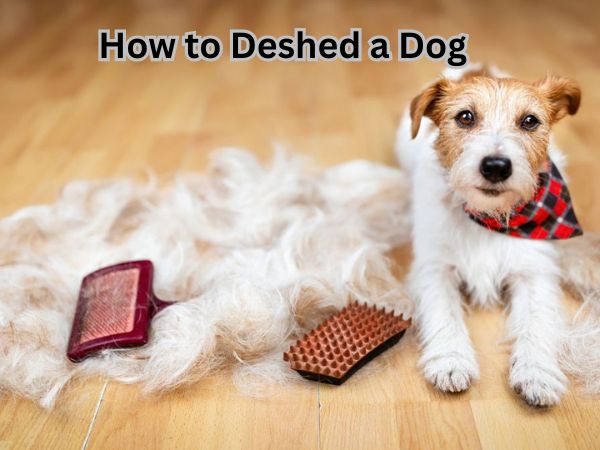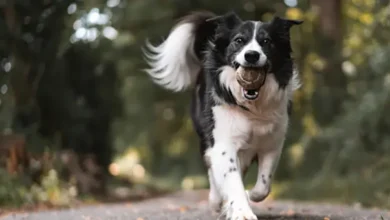How to Deshed a Dog: 7 Powerful Tricks That Really Work

MixbreedDogs.com is an Amazon Associate, and we earn from qualifying purchases.
How to Deshed a Dog is a crucial grooming step that every pet owner should know. Shedding is a natural part of a dog’s life, but when loose fur starts piling up on furniture, clothes, and floors, it becomes a frustrating challenge. Deshedding goes beyond regular brushing—it’s about removing loose, dead undercoat hairs before they scatter around your home. Not only does this keep your house cleaner, but it also promotes your dog’s comfort and skin health by preventing mats and irritation. Regular deshedding helps your dog stay cooler during warm months and reduces allergens, creating a healthier environment for everyone.
If shedding has ever felt overwhelming, mastering how to deshed your dog effectively will ease your cleaning routine and leave your furry friend happier and looking their best. This article will share 7 powerful tricks that really work to tackle shedding once and for all.
What is Deshedding?
If you’ve ever found dog hair on your favorite black shirt or watched tumbleweeds of fur roll across your living room floor, you’re already familiar with the challenge of dog shedding. But what exactly is deshedding, and how is it different from your regular grooming routine?
Deshedding is a specialized grooming technique that targets your dog’s undercoat – that fluffy, insulating layer beneath the topcoat that naturally sheds throughout the year. Unlike regular brushing that smooths the surface and removes tangles, deshedding goes deeper to remove loose, dead hair before it ends up all over your home.
Deshedding vs. Regular Grooming
Here’s how deshedding differs from your typical dog grooming routine:
Regular Brushing:
- Focuses on the outer coat
- Removes surface tangles and mats
- Distributes natural oils
- Keeps fur looking neat and shiny
Deshedding:
- Targets the dense undercoat
- Removes loose hair at the root level
- Significantly reduces future shedding
- Uses specialized tools designed to reach deeper layers
Why Deshedding Matters
Think of deshedding as preventive maintenance for your home and your dog’s comfort. When you remove that loose undercoat before it naturally falls out, you’re:
- Reducing the amount of hair around your house
- Helping your dog feel more comfortable
- Preventing matting and skin irritation
- Keeping your dog’s coat healthier overall
The bottom line: While regular brushing keeps your dog looking good on the surface, deshedding tackles the root cause of excessive shedding by addressing what’s happening underneath.
Benefits of Deshedding Your Dog
Regular deshedding isn’t just about keeping your home tidy – it’s a game-changer for both you and your furry friend. Let’s explore why this simple grooming practice makes such a big difference.
Keep Your Home Hair-Free
Nobody wants to find dog hair in their morning coffee! Regular deshedding helps you:
- Reduce vacuum time – Less hair on furniture means easier cleaning
- Protect your clothes – Say goodbye to lint rollers on every outfit
- Create a cleaner environment – Your guests will notice the difference
- Save money – Less wear on your vacuum and air filters
Boost Your Dog’s Coat Health
Think of deshedding as a spa day for your pup. Here’s what it does:
- Prevents painful matting – Removes loose fur before it tangles
- Improves air circulation – Helps skin breathe and stay healthy
- Distributes natural oils – Creates a shinier, softer coat
- Reduces hot spots – Better airflow means less skin irritation
Control Allergens Naturally
If allergies make life difficult, deshedding can help:
- Removes dander buildup – The main culprit behind pet allergies
- Reduces airborne particles – Fewer allergens floating around your home
- Creates breathing space – Literally easier for sensitive family members
- Works better than air purifiers – Tackles the problem at its source
Regular deshedding works best when done 2-3 times per week, depending on your dog’s coat type. Your four-legged friend will love the attention, and you’ll love the results!
7 Powerful Tricks to Deshed Your Dog
1.Choose the Right Deshedding Tool
Finding the perfect deshedding tool can feel overwhelming with so many options out there. But don’t worry – it’s easier than you think once you know what to look for!
Match Your Tool to Your Dog’s Coat
Short-Haired Dogs (Labs, Beagles, Bulldogs):
- Rubber curry brushes – Great for daily use and massage
- Bristle brushes – Perfect for removing loose hair gently
- Deshedding gloves – Makes brushing feel like petting
Medium-Haired Dogs (Golden Retrievers, Border Collies):
- Pin brushes – Ideal for regular maintenance
- Slicker brushes – Excellent for tackling mats and tangles
- Undercoat rakes – Essential for double-coated breeds
Long-Haired Dogs (Afghan Hounds, Shih Tzus):
- Wide-tooth combs – Prevents breakage while detangling
- Metal pin brushes – Reaches through thick coats
- Dematting tools – Safely removes stubborn mats
Pro Tips for Tool Selection
- Start gentle – Always begin with softer brushes and work up
- Quality matters – Invest in a good deshedding brush – it lasts longer and works better
- Test first – Try tools on a small area to see how your dog reacts
- Multiple tools – Most dogs benefit from having 2-3 different deshedding tools
Remember, the best deshedding brush is one your dog actually enjoys! Take time to find what works for your furry friend’s unique coat and personality.
2.Brush Regularly and Correctly
Getting the brushing routine right is your secret weapon against endless dog hair everywhere. But here’s the thing – it’s not just about grabbing any brush and going to town. The way you brush matters just as much as how often you do it.
Master the Line Brushing Technique
Line brushing sounds fancy, but it’s actually pretty simple once you get the hang of it. Here’s how to do it:
- Part the fur in sections – Work in small areas, about 2-3 inches wide
- Brush from the skin outward – Start at the base and work your way to the tips
- Move systematically – Go line by line across your dog’s body
- Don’t rush – Take your time with each section
This method gets deeper into the undercoat where most shedding happens. Think of it like mowing your lawn in neat rows – you don’t want to miss any spots!
Avoid Brush Burn at All Costs
Nobody wants to hurt their furry friend while trying to help them. Brush burn happens when you brush too hard or use the wrong technique. Here’s how to keep your pup comfortable:
- Use gentle pressure – Let the brush do the work, not your arm
- Watch for red skin – Stop immediately if you see any irritation
- Take breaks – Split longer sessions into shorter ones
- Choose the right brush – Slicker brushes work great, but don’t press too hard
Your dog should enjoy brushing time, not dread it. If they’re pulling away or seem uncomfortable, you might be brushing too aggressively.
How Often Should You Brush?
The golden rule? Daily brushing during shedding season, and at least 2-3 times per week otherwise. Heavy shedders like Golden Retrievers or German Shepherds might need daily attention year-round.
Start with just 5-10 minutes if your dog isn’t used to it. Most dogs actually love the attention once they get comfortable with the routine.
3.Use Deshedding Shampoos and Conditioners
When it comes to managing your furry friend’s shedding, the right products can make all the difference. Deshedding shampoos and conditioners are specially formulated to tackle loose fur before it ends up all over your furniture.
Why Choose Specialized Deshedding Products?
Regular dog shampoos clean your pet, but deshedding shampoo goes the extra mile. These products contain ingredients that:
- Loosen dead hair – Making it easier to remove during bath time
- Nourish the skin – Healthy skin means healthier coat growth
- Reduce future shedding – Regular use helps minimize loose fur
- Strengthen existing hair – Less breakage means less mess around the house
What Makes These Products Special?
Dog grooming products designed for deshedding often include:
- Omega fatty acids – Keep your dog’s coat shiny and strong
- Natural oils – Moisturize dry skin that can cause excess shedding
- Gentle cleansers – Remove dirt without stripping natural oils
- Conditioning agents – Make brushing easier after the bath
Getting the Best Results
For maximum effectiveness:
- Use lukewarm water during bath time
- Massage the shampoo thoroughly into your dog’s coat
- Let conditioner sit for 2-3 minutes before rinsing
- Follow up with a good brushing session while the coat is damp
Remember, consistency is key. Using these specialized products every few weeks can significantly reduce the amount of fur you’ll find around your home.
4.Bathe Your Dog Properly
Getting your dog’s bathing routine right can make a huge difference in managing shedding. Think of it as hitting the reset button on your pup’s coat – when done properly, a good bath can remove loose fur before it ends up all over your furniture!
How Often Should You Bathe Your Shedding Dog?
Most dogs don’t need weekly baths, but shedding season might call for different rules:
- Regular shedders: Every 4-6 weeks is usually perfect
- Heavy shedding seasons: Every 2-3 weeks can help manage the fur explosion
- Double-coated breeds: Monthly baths work best (over-bathing can damage their natural oils)
- Short-haired dogs: Can go 6-8 weeks between baths
Pro tip: Your dog’s lifestyle matters too. If Buddy loves rolling in mud puddles, he’ll need more frequent baths than a couch potato pup!
Choosing the Right Dog Shampoo for Shedding
Not all dog shampoos are created equal. Here’s what to look for:
Best Shampoo Types:
- Deshedding shampoos – specifically designed to loosen dead fur
- Oatmeal-based formulas – gentle and moisturizing
- Omega-3 enriched shampoos – promote healthy skin and coat
What to Avoid:
- Human shampoo (it’s too harsh for dog skin)
- Products with artificial fragrances
- Shampoos with sulfates that can dry out the skin
Bath Time Tips That Actually Work
Before the bath:
- Brush your dog thoroughly to remove loose fur
- Use lukewarm water (test with your elbow like you would for a baby)
During the bath:
- Work the shampoo into a good lather
- Massage gently – your dog will love the attention
- Pay extra attention to areas where fur tends to mat
The golden rule: A relaxed dog sheds less during bath time, so keep the experience positive with treats and gentle praise!
Remember, consistency is key. Regular baths with the right products will keep your dog’s coat healthy and reduce the amount of fur floating around your home.
5.Blow-Dry to Remove Loose Fur
If you have a fluffy dog breed, you’ve probably noticed how much fur can hide in their thick coat. Here’s where blow-drying becomes your best friend for deshedding.
Why Blow-Drying Works So Well
Think of your dog’s coat like a thick sweater. When it’s damp, loose fur sticks together and stays trapped. But when you blow-dry, the warm air lifts and separates each hair, making loose fur easy to remove.
This method works especially well for:
- Golden Retrievers
- German Shepherds
- Huskies
- Pomeranians
- Any double-coated breed
The Right Way to Blow-Dry Your Dog
Before You Start
- Use a dog blow dryer (never a human one – too hot!)
- Make sure your dog is clean and slightly damp
- Have your brush ready
Step-by-Step Process
- Start on low heat – Your dog’s skin is sensitive
- Work in sections – Don’t try to do everything at once
- Brush while drying – This catches loose fur as it lifts
- Keep moving – Don’t focus on one spot too long
Pro Tips for Success
Keep your dog calm:
- Let them sniff the dryer first
- Start far away and move closer slowly
- Give treats throughout the process
Watch the temperature:
- Your hand should feel warm, not hot
- If it’s too hot for your hand, it’s too hot for your dog
What to Expect
You’ll be amazed at how much loose fur comes out! Don’t worry – this is normal and healthy. Your dog will look fluffier and feel more comfortable without all that dead fur weighing them down.
Remember: This works best right after a bath when the fur is still slightly damp. The combination of clean fur and gentle heat creates the perfect conditions for easy deshedding.
6.Maintain a Healthy Diet for Coat Health
Your dog’s diet plays a huge role in how much they shed. Think of it like this – when you eat well, your hair looks shiny and healthy. The same goes for your furry friend!
What Your Dog’s Coat Needs
A healthy coat starts from the inside out. Here’s what makes the biggest difference:
Essential Nutrients for Less Shedding
- Omega-3 fatty acids – Found in fish oil and salmon
- Omega-6 fatty acids – Present in chicken fat and vegetable oils
- High-quality protein – Builds strong hair follicles
- Zinc and biotin – Support healthy skin and coat growth
- Vitamin E – Acts as a natural antioxidant for skin health
Simple Diet Changes That Work
Choose Premium Dog Food
Look for foods where real meat is the first ingredient. Avoid fillers like corn and wheat that don’t add nutritional value.
Add Natural Supplements
- Fish oil capsules – Give 1-2 per day based on your dog’s size
- Coconut oil – Start with 1/4 teaspoon daily
- Raw eggs – Once a week for extra protein and shine
Fresh water helps maintain skin moisture. A well-hydrated dog sheds less and has a softer coat.
Signs Your Diet Changes Are Working
You’ll notice less hair on your furniture within 4-6 weeks. Your dog’s coat will feel softer and look shinier too. Remember, consistency is key – stick with the new routine for best results!
7.Regular Professional Grooming
When and Why to Seek Professional Help
Sometimes, even the best at-home deshedding routine needs a professional touch. Professional dog grooming services can be a game-changer for managing your furry friend’s shedding.
When to Visit a Professional Groomer
- Seasonal shedding peaks – Spring and fall when your dog “blows their coat”
- Double-coated breeds – Huskies, Golden Retrievers, and German Shepherds need expert care
- Matted or tangled fur – When brushing at home isn’t enough
- Special events – Before family gatherings or photos
- Every 6-8 weeks – For regular maintenance and health checks
Why Professional Groomer Deshedding Works Better
- Specialized tools – High-velocity dryers and professional deshedding equipment
- Expert technique – Groomers know breed-specific shedding patterns
- Deep clean – Removes loose undercoat you can’t reach at home
- Saves time – What takes you hours, they do in 30 minutes
- Stress-free – Many dogs actually enjoy the professional grooming experience
What to Expect
A professional deshedding service typically includes a thorough brush-out, special shampoo, blow-dry, and final brushing. Your groomer will also check for skin issues and give you tips for home maintenance.
Conclusion
Remember, every dog sheds differently. What works for your neighbor’s Golden Retriever might need tweaking for your Border Collie.Start with one or two tricks this week. Notice which ones your dog enjoys most. Build from there.
Need more help? Consider booking a session with a professional groomer. They can show you breed-specific techniques and recommend the best tools for your furry friend.Your dog will thank you with a healthier coat and fewer tumbleweeds of fur rolling across your floors!
FAQ
What is the best way to deshed a dog?
The best way to deshed a dog is by brushing them daily with a deshedding tool. This removes loose fur before it falls out. Regular grooming, a healthy diet, and occasional baths with deshedding shampoo also help reduce shedding.
How often should I deshed my dog?
You should deshed your dog once or twice a week during heavy shedding seasons. For dogs that shed year-round, regular brushing every few days works best. This keeps their coat healthy and reduces fur around your home.
Do deshedding brushes really work?
Yes, deshedding brushes work very well. They reach the undercoat and remove loose hair that normal brushes miss. Using them regularly prevents mats, reduces shedding, and keeps your dog’s coat shiny and comfortable.
What home remedies help with dog shedding?
Home remedies include feeding your dog omega-3 fatty acids, brushing daily, keeping them hydrated, and bathing with gentle shampoo. A balanced diet and regular grooming are the easiest ways to reduce shedding naturally at home.
Can diet affect how much my dog sheds?
Yes, diet plays a big role in shedding. Dogs with poor nutrition shed more. Feeding high-quality food with protein, vitamins, and omega-3 fatty acids supports skin and coat health, which reduces excess shedding.



